Sommaire
Guide : tout savoir sur le mouillage
Le mouillage du bateau est une manœuvre qui consiste à immobiliser le bateau en mer, grâce à une ancre de bateau, chaine ou cordage. C’est une manœuvre indispensable à maîtriser pour tout plaisancier, que ce soit pour faire une pause, passer la nuit ou faire face à une avarie. Mais le mouillage n’est pas si simple qu’il y paraît : il faut choisir un bon emplacement, utiliser le bon matériel, respecter la réglementation et les autres usagers, et veiller à la sécurité du bateau et de l’équipage.
Dans ce guide, nous vous expliquons tout ce qu’il faut savoir sur le mouillage du bateau : Ce guide vise à fournir une compréhension approfondie du mouillage, en abordant sa définition, son fonctionnement et la réglementation qui l’entoure. De la sélection de l’emplacement idéal de l’ancrage du bateau au choix des équipements adéquats, en passant par les bonnes pratiques environnementales et de sécurité, cet article vous aidera à maîtriser les aspects fondamentaux du mouillage du bateau. Bonne lecture !
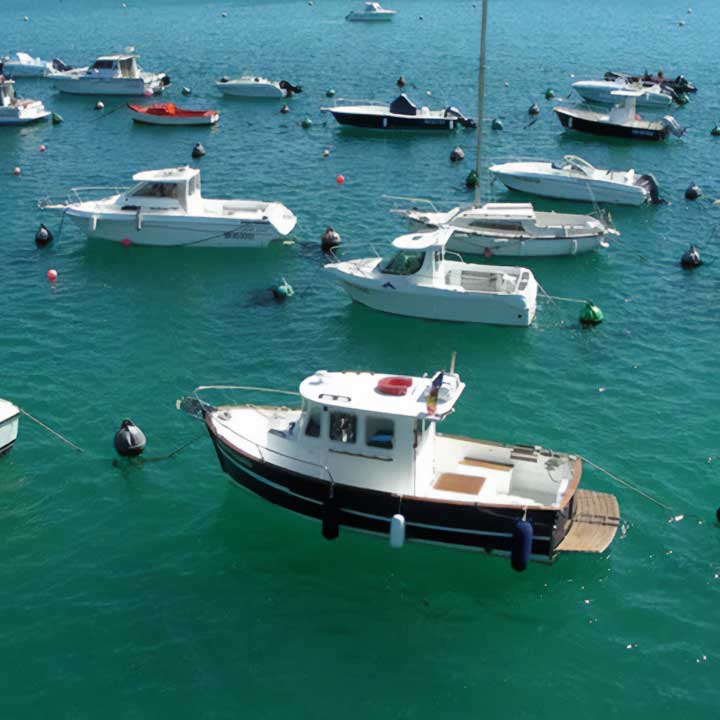
Guide : tout savoir sur le mouillage
Le mouillage du bateau est une manœuvre qui consiste à immobiliser le bateau en mer, grâce à une ancre, chaine ou cordage. C’est une manœuvre indispensable à maîtriser pour tout plaisancier, que ce soit pour faire une pause, passer la nuit ou faire face à une avarie. Mais le mouillage n’est pas si simple qu’il y paraît : il faut choisir un bon emplacement, utiliser le bon matériel, respecter la réglementation et les autres usagers, et veiller à la sécurité du bateau et de l’équipage.
Dans ce guide, nous vous expliquons tout ce qu’il faut savoir sur le mouillage du bateau : Ce guide vise à fournir une compréhension approfondie du mouillage, en abordant sa définition, son fonctionnement et la réglementation qui l’entoure. De la sélection de l’emplacement idéal au choix des équipements adéquats, en passant par les bonnes pratiques environnementales et de sécurité, cet article vous aidera à maîtriser les aspects fondamentaux du mouillage du bateau. Bonne lecture !
Qu'est ce que le mouillage d'un bateau ?
Définition du mouillage en bateau
On peut retrouver différent terme pour indiquer le mouillage. On parle d’arrêt, d’ancrage lorsque le mouillage se fait à l’ancre, d’amarrage, de stationnement. Mouiller en bateau, c’est simplement l’action de fixer un bateau à un emplacement spécifique en utilisant des dispositifs tels qu’une ancre, des chaînes et des cordages. Il s’agit d’une technique qui permet au navire de rester stationnaire, que ce soit en haute mer, près d’une côte ou dans un port.
Le mouillage est essentiel pour diverses situations, telles que les arrêts prolongés, les périodes de repos, les activités de pêche, ainsi que pour éviter les dangers tels que les tempêtes ou les courants forts. Il existe différents types de mouillages et réglementation, selon le matériel utilisé, la durée et le but du stationnement. Mais les techniques varieront aussi en fonction de la météo, la profondeur, le courant etc…
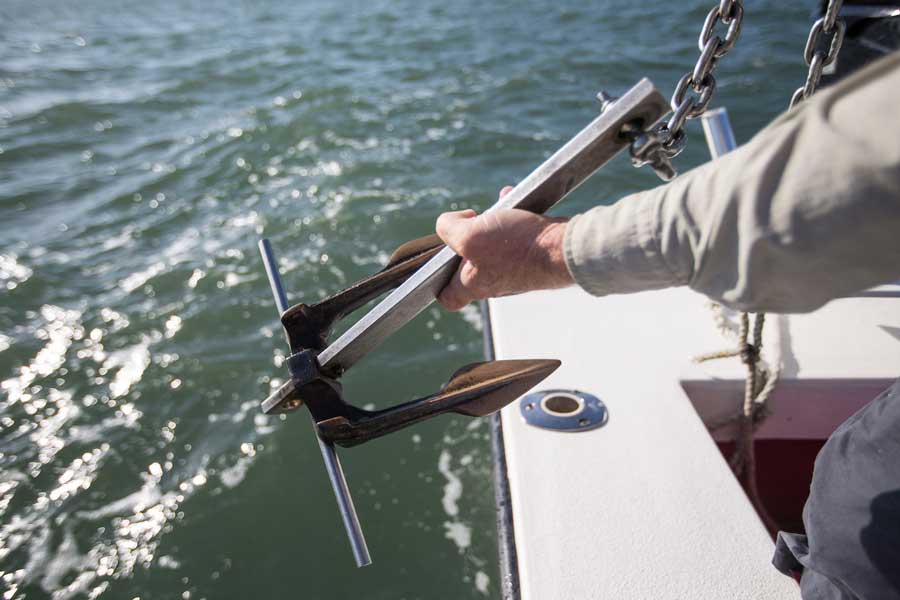
Différent types de mouillage
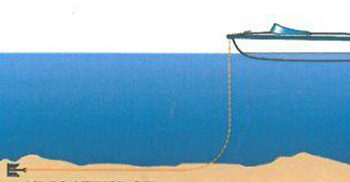 Le mouillage simple avec une seule ancre est la technique de mouillage la plus courante et la plus facile à réaliser. Elle consiste à laisser tomber une ancre à l’avant du bateau, puis à reculer en dévidant la ligne de mouillage jusqu’à ce que l’ancre s’enfouisse dans le fond. Cette méthode permet au bateau d’éviter autour de son ancre en fonction du vent et du courant. Le mouillage avec une seule ancre nécessite peu de matériel et de manœuvres, mais il faut veiller à choisir un bon endroit pour mouiller, à respecter un ratio suffisant entre la longueur de la ligne de mouillage et la profondeur de l’eau, et à surveiller régulièrement le comportement du bateau.
Le mouillage simple avec une seule ancre est la technique de mouillage la plus courante et la plus facile à réaliser. Elle consiste à laisser tomber une ancre à l’avant du bateau, puis à reculer en dévidant la ligne de mouillage jusqu’à ce que l’ancre s’enfouisse dans le fond. Cette méthode permet au bateau d’éviter autour de son ancre en fonction du vent et du courant. Le mouillage avec une seule ancre nécessite peu de matériel et de manœuvres, mais il faut veiller à choisir un bon endroit pour mouiller, à respecter un ratio suffisant entre la longueur de la ligne de mouillage et la profondeur de l’eau, et à surveiller régulièrement le comportement du bateau.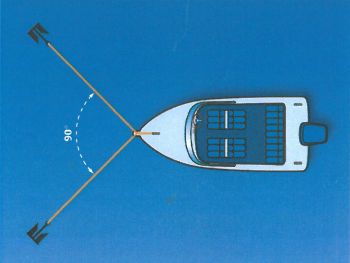
L’affourchage est une technique de mouillage consistant à mouiller deux ancres en forme de V à l’avant du bateau, avec un angle compris entre 60 et 120 degrés. Cette méthode permet de limiter le rayon d’évitage du navire. Attention cependant, l’affourchage n’améliore pas la tenue du mouillage en cas de mauvais temps, car les ancres travaillent successivement plutôt qu’en même temps. Pour une meilleure tenue, il est recommandé de maintenir un angle maximum de 30 degrés entre les deux lignes de mouillage. Il convient également de mentionner que l’affourchage est utilisé lorsque le vent monte rapidement et que l’on n’a pas le temps d’empenneler.
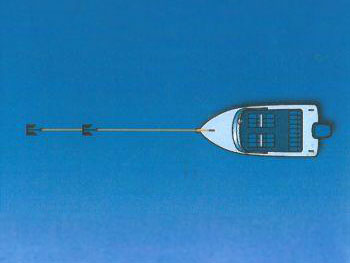
L’empennelage est une technique de mouillage qui consiste à ajouter une deuxième ligne de mouillage à l’ancre principale. Cette deuxième ligne est plus longue que la profondeur de l’eau. L’empennelage est particulièrement utile lors de mauvais temps, car il améliore la résistance aux vents forts. Les deux ancres travaillent dans le même axe, ce qui augmente considérablement la tenue du mouillage. Pour faciliter la remontée du mouillage, il est recommandé de laisser une distance entre les deux ancres supérieure à la profondeur de l’eau, permettant ainsi de remonter la première ancre alors que l’autre est toujours posée au fond. Il convient de noter que l’empennelage nécessite une anticipation lors du mouillage, car les deux ancres doivent être correctement enfouies. De plus, il faut faire preuve de prudence lors de la remontée du mouillage pour éviter les éventuels enchevêtrements des deux lignes. L’empennelage offre une meilleure stabilité et une résistance accrue, en particulier lorsque les conditions météorologiques sont difficiles, mais il peut être plus complexe à mettre en œuvre que le mouillage avec une seule ancre.
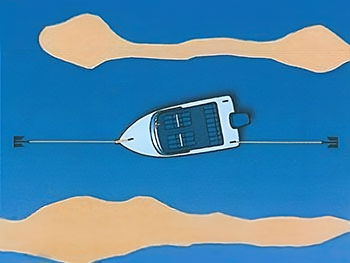
L’embossage est une technique de mouillage qui consiste à ajouter un mouillage à l’arrière du bateau en plus de l’ancre principale à l’avant. Cette méthode permet de maintenir le bateau dans son axe, en particulier dans des zones où il est impossible d’éviter, comme les fleuves. L’embossage est souvent utilisé lorsque le bateau est très proche des côtes ou lorsque les environs sont encombrés. Cette technique vise à supprimer l’évitage, c’est-à-dire les mouvements de rotation du bateau autour de son ancre. Cependant, il convient de noter que l’embossage est adapté aux conditions météorologiques calmes, car si le vent vient par le travers, les ancres ne travaillent pas correctement, ce qui peut affecter la tenue du mouillage. L’embossage peut être réalisé en utilisant une ancre à l’avant du bateau (l’ancre principale) et une autre à l’arrière (appelée « ancre de détroit » ou secondaire), ce qui permet de maintenir le bateau dans l’axe du courant ou dans une position spécifique, par exemple lors d’un échouage volontaire.
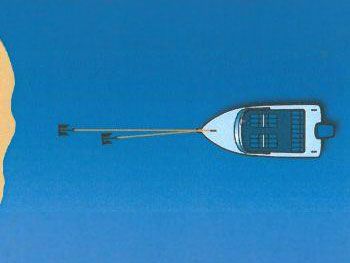 La technique de mouillage en barbe est une méthode moins couramment utilisée. Elle offre l’avantage de faire travailler deux ancres en même temps. Pour effectuer cette technique, vous devrez d’abord mouiller la première ancre, puis reculer d’environ vingt mètres avant de mouiller la deuxième ancre et d’enfiler la longueur de ligne souhaitée. Cependant, il est essentiel de faire attention à ne pas emmêler les deux lignes de mouillage. La technique « en barbe » présente deux problèmes potentiels : elle est moins performante que d’autres méthodes de mouillage, et il existe un risque d’enchevêtrement des lignes de mouillage.
La technique de mouillage en barbe est une méthode moins couramment utilisée. Elle offre l’avantage de faire travailler deux ancres en même temps. Pour effectuer cette technique, vous devrez d’abord mouiller la première ancre, puis reculer d’environ vingt mètres avant de mouiller la deuxième ancre et d’enfiler la longueur de ligne souhaitée. Cependant, il est essentiel de faire attention à ne pas emmêler les deux lignes de mouillage. La technique « en barbe » présente deux problèmes potentiels : elle est moins performante que d’autres méthodes de mouillage, et il existe un risque d’enchevêtrement des lignes de mouillage.
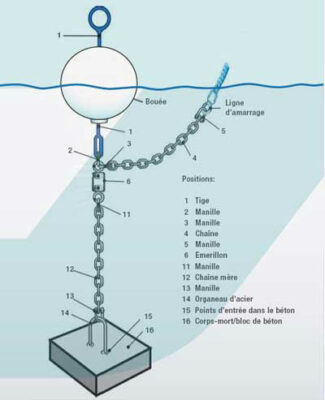
Mouiller sur un coffre (ou bouée de mouillage) offre plusieurs avantages : ils préservent les fonds marins en évitant un impact négatif, et ils offrent également une solution sécurisée grâce à leur solide ancrage dans le sol. On appelle « coffre » ce qui s’apparente le plus souvent à un « corps-mort » (bloc de béton pouvant peser jusqu’à 4 tonnes) qui est posé au fond de l’eau, duquel remonte une bouée fixée à une chaine. Pour se fixer à un coffre, préparez une amarre solide à l’avant de votre bateau, utilisez une gaffe au cas où le coffre serait plus bas que votre bateau, approchez-vous du coffre face à l’élément dominant (vent ou courant) à vitesse réduite, attrapez la ligne d’amarrage avec votre gaffe et assurez-vous de vous amarrer solidement. Dans certaines situations, il peut être nécessaire de s’amarrer sur deux coffres en utilisant la même technique.
Choix de la zone de mouillage et préparation
Comment choisir un endroit pour mouiller ?
Le choix du lieu de mouillage dépend de plusieurs facteurs, tels que :
- La météo et son évolution : il faut choisir un mouillage abrité des vents dominants et des vagues, et anticiper les changements éventuels de direction ou de force du vent.
- La marée : il faut connaître la hauteur d’eau maximale et minimale pendant la durée du mouillage, et s’assurer d’avoir toujours assez de fond sous le bateau pour éviter l’échouage. À savoir : à marée basse le cercle d’évitage est plus grand qu’à marée haute.
- La nature des fonds : il faut privilégier les fonds sableux ou vaseux, qui offrent une bonne accroche pour l’ancre, et éviter les fonds rocheux ou coralliens, qui peuvent endommager l’ancre ou la flore locale.
- L’espace disponible : il faut respecter une distance suffisante avec les autres bateaux, la côte ou les obstacles, en tenant compte de la zone d’évitement du bateau, c’est-à-dire du cercle qu’il décrit autour de son ancre en fonction du vent et du courant.
- La facilité du débarquement : il faut tenir compte de la possibilité et du confort pour rejoindre la terre ferme avec une annexe ou à la nage, selon les besoins ou les envies.
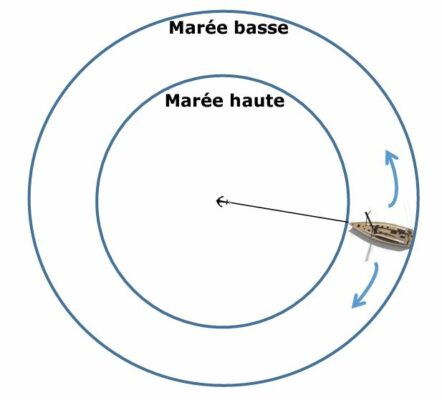
Comment préparer le matériel pour mouiller ?
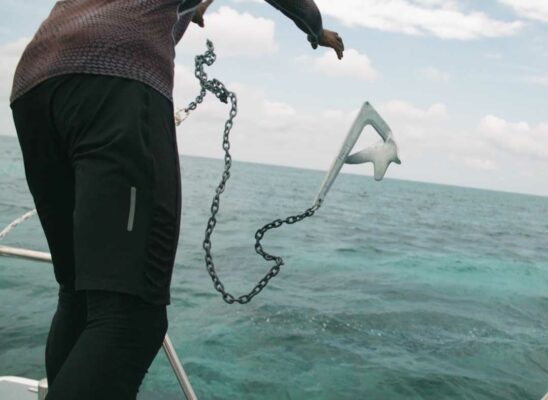
Le matériel nécessaire pour mouiller comprend :
- Une ancre adaptée au type de fond et au poids du bateau. Il existe différentes formes d’ancres, dont certaines cherchent à pénétrer dans le fond, tandis que d’autres se contentent de s’y accrocher. Il est conseillé d’avoir au moins deux ancres à bord, une principale et une secondaire, pour faire face aux différentes situations.
- Une ligne de mouillage constituée d’une chaîne ou d’un cordage, ou d’une combinaison des deux. La chaîne offre plus de poids et de résistance que le cordage, mais elle est aussi plus encombrante et plus bruyante. Le cordage offre plus de souplesse et d’élasticité que la chaîne, mais il est aussi plus sensible à l’usure et aux nœuds. La longueur de la ligne de mouillage doit être au moins égale à trois fois la hauteur d’eau par temps calme, et au moins dix fois par vent fort.
- Un guindeau, davier, et taquet (facultatif) afin de remonter et bloquer la ligne de mouillage sans effort. Le point d’attache doit être solide et sécurisé. Le guindeau peut être manuel ou électrique. Consultez notre guide : Choisir son guindeau.
- Des gants et des bottes (facultatif) pour se protéger les mains et les pieds lors de la manipulation de l’ancre et de la ligne de mouillage.
Quelle ancre choisir pour le mouillage ?
Pour choisir la bonne ancre pour votre bateau il faudra prendre en compte :
- Le type de fond marin sur lequel on souhaite mouiller, va déterminer la forme et la capacité de pénétration de l’ancre. Il existe des ancres adaptées aux fonds meubles (sable, vase), comme les ancres plates ou les ancres charrue, des ancres adaptées aux fonds durs (roche, corail) etc… (cf. tableau ancre/type de sol)
- Le poids et la longueur du bateau, vont déterminer la taille et le poids de l’ancre. Il faut choisir une ancre proportionnelle au bateau, ni trop légère ni trop lourde et tenir compte de la prise au vent du bateau. (cf. tableau poids/taille bateau)
- Le matériau de l’ancre, va influencer sa résistance à la corrosion et à l’usure. Il existe des ancres en acier galvanisé, en acier inoxydable ou en aluminium. Les ancres en acier galvanisé sont les plus courantes et les moins chères, mais elles peuvent se rouiller avec le temps. Les ancres en acier inoxydable sont plus esthétiques et plus durables, mais elles sont aussi plus chères. Les ancres en aluminium sont plus légères et plus faciles à manipuler, mais elles sont aussi plus fragiles et moins adaptées aux fonds durs.
- L’installation à bord, qui va dépendre de l’espace disponible et du système de remontée de l’ancre. Il faut choisir une ancre qui soit compatible avec le davier du bateau, c’est-à-dire le support qui permet de maintenir l’ancre à l’avant du bateau. Il faut aussi choisir une ancre qui soit facile à stocker dans le puits à chaîne ou dans un coffre
Quelle ancre selon le type de sol ?



Ancre Bruce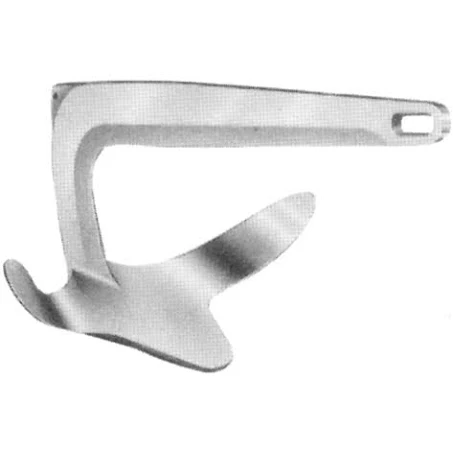 |
Ancre Charrue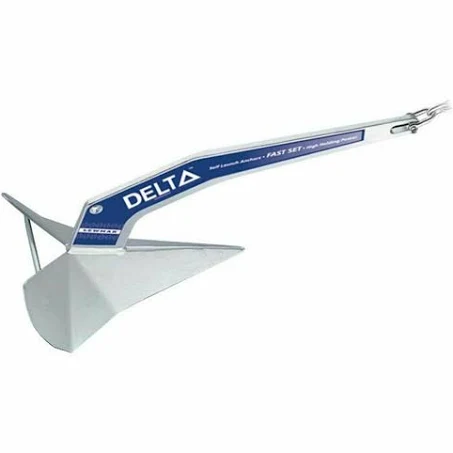 |
Ancre Plate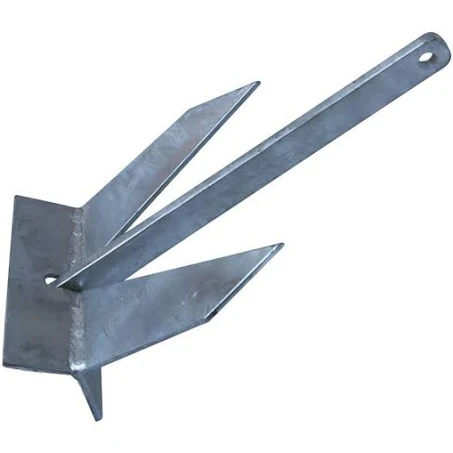 |
Ancre à jas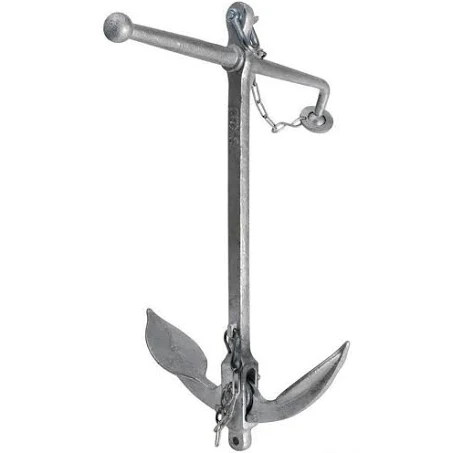 |
Grappin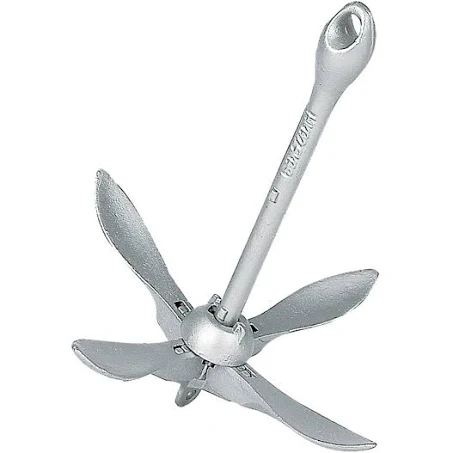 |
|
|---|---|---|---|---|---|
| Vase | ✅ | ✅ | ✅ | ❌ | ⚠️ |
| Boue | ✅ | ✅ | ⚠️ | ⚠️ | ❌ |
| Sable | ✅ | ⚠️ | ✅ | ❌ | ❌ |
| Algues | ❌ | ⚠️ | ⚠️ | ✅ | ✅ |
| Roche | ⚠️ | ❌ | ⚠️ | ✅ | ✅ |
Quelle poids d'ancre selon la taille du bateau ?
| Longueur du bateau | Déplacement du bateau | Poids minimum de l'ancre | Diamètre chaine | Diamètre cablot | Diamètre manille |
|---|---|---|---|---|---|
| jusqu'à 4m | 300 Kg | 3.5 Kg | 6 mm | 6-8 mm | 8 mm |
| 5.50m | 800 Kg | 6 Kg | 6 mm | 10 mm | 8 mm |
| 6.50m | 1 000 Kg | 8 Kg | 6-7 mm | 10 mm | 8 mm |
| 7,50 m | 2000 Kg | 10 kg | 8 mm | 14 mm | 10 mm |
| 9 m | 3000 Kg | 12 Kg | 8 mm | 14 mm | 10 mm |
| 10,50 m | 4500 Kg | 14 Kg | 8 mm | 14 mm | 10 mm |
| 12,50 m | 8000 Kg | 16 Kg | 10 mm | 18 mm | 12 mm |
Veuillez noter que les valeurs indiquées sont des estimations générales et peuvent varier en fonction d’autres facteurs spécifiques à votre bateau comme la longueur du mat pour un bateau à voile etc… Nous vous recommandons de consulter les spécifications du fabricant de l’ancre
Longueur de chaîne conseillée
Pour savoir combien de longueur de mouillage il faut mettre à l’eau, il faut prendre en compte la hauteur d’eau sous le bateau, qui dépend de plusieurs éléments :
- La profondeur indiquée sur la carte, qui est la hauteur d’eau à marée basse.
- Le marnage, qui est la différence de hauteur d’eau entre la marée haute et la marée basse.
- La hauteur de l’étrave, qui est la distance entre le pont du bateau et la surface de l’eau.
En faisant la somme de ces trois éléments, on obtient la hauteur d’eau réelle sous le bateau. Ensuite, il faut multiplier cette hauteur par un ratio (par exemple 3 ou 10 selon les conditions) pour obtenir la longueur de mouillage à déployer.
Par exemple, si la profondeur indiquée sur la carte est de 5 mètres, le marnage de 2 mètres, la hauteur de l’étrave de 1 mètre, et le ratio de 3, alors la longueur de mouillage à mettre à l’eau est de : (5 + 2 + 1) x 3 = 24 mètres.
Le ratio dépend de la durée prévue et des conditions :
- S’ancrer le temps d’un repas : un rapport de 3 / 1
- S’ancrer pour la nuit par temps calme : un rapport de 5 / 1
- S’ancrer pour la nuit si le vent souffle : un rapport de 7 / 1
- S’ancrer pour la nuit dans le gros temps : un rapport de 10 / 1
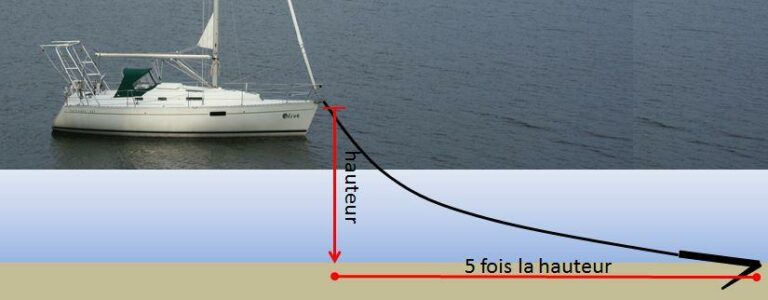
Comment réaliser la manœuvre pour mouiller ?
LA sécurité au mouillage
Une fois le bateau positionné sur une zone de mouillage adéquate et avant d’entamer la manœuvre de mouillage simple ci dessous, il faudra prendre en compte et vérifier plusieurs éléments de sécurité :
- Assurez-vous d’avoir accès facile au lieu de mouillage en tout temps.
- Vérifiez les heures et les hauteurs des marées avant de mouiller.
- Utilisez le type d’ancre approprié en fonction du type de fond marin.
- Prenez des mesures de sécurité pour éviter les situations de personne à la mer pendant la nuit, telles que ranger correctement le bateau et attacher une ligne flottante avec une bouée de sauvetage.
- Activez une alarme de déplacement, comme celle d’un traceur GPS, pour être averti en cas de dérive.
- N’oubliez pas d’allumer le feu de mouillage conformément aux règlements en vigueur.
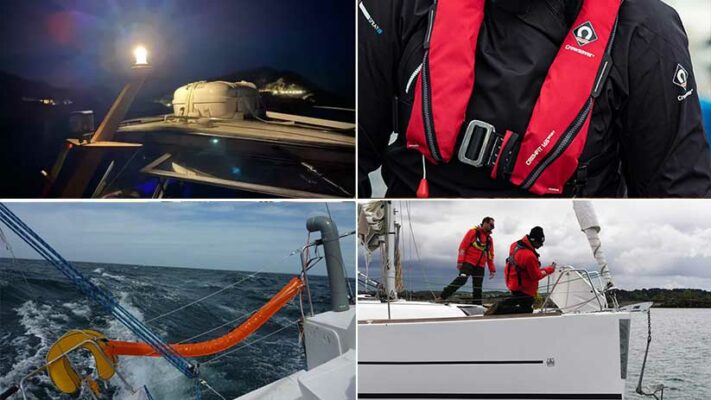
Mouillage simple
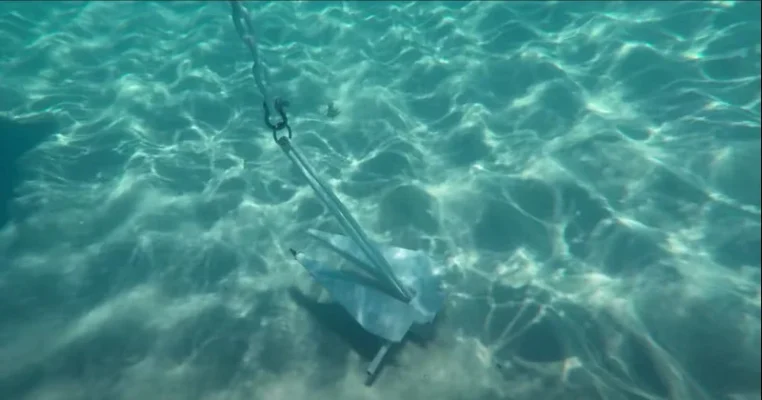
Manœuvre de mouillage simple avec une seule ancre :
- Trouvez une zone de mouillage adapté. (cf. Choix de la zone de mouillage).
- Approchez de la zone face au vent. (Observer l’orientation des autres embarcations est une bonne indication de la direction à prendre pour l’approche.)
- Placez la chaine sur le davier et sortez la longueur de chaine requise (cf. Longueur de chaine conseillée).
- Faites descendre l’ancre graduellement, à la main ou avec le guindeau. (avec un guideau utilisez une griffe : un cordage fixé à la chaine et au taquet afin de soulager le guindeau)
- Quand l’ancre touche le fond, reculez à mi régime pendant 30 sec pour faire crocher l’ancre.
- Surveillez régulièrement la tenue du mouillage pour vous assurer qu’il reste sécurisé en appliquant une tension sur la chaîne.

LEVER L'ANCRE
Manœuvre pour lever l’ancre et sortir du mouillage (idéalement à 2) :
- Le barreur démarre le moteur et avance lentement par à-coups, veillant à ne pas passer au-dessus de la chaîne d’ancre.
- L’équipier à l’avant prend le mou de l’aussière tout en indiquant au barreur la direction à suivre. Une fois tout le mou de l’aussière pris, il informe le barreur qu’il est « à long pic« .
- L’équipier continue à prendre le mou de l’aussière jusqu’à ce que le bateau soit « à pic« . Il avertit alors le barreur, qui met le moteur au point mort.
- L’équipier décroche et remonte l’ancre, puis informe le barreur qu’elle est décrochée.
- Le barreur manœuvre doucement au moteur, en laissant à l’équipier le temps de ranger et de stabiliser correctement l’ancre sur le davier ou dans le puits d’ancre.
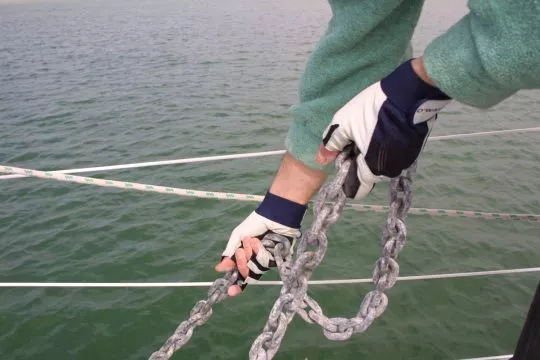

Respecter son environnement
Amarrer son bateau lors d’un arrêt ou pour un mouillage prolongé ne signifie pas simplement jeter l’ancre dans l’eau et effectuer la manœuvre appropriée. En tant que marin, il est primordial de prendre conscience que le mouillage est bien plus qu’une simple action mécanique. C’est une responsabilité envers l’environnement marin fragile qui nous entoure. Pour préserver les écosystèmes marins et minimiser notre impact, voici 4 principes fondamentaux à respecter :
- Choix attentif de l’emplacement de mouillage : Choisir avec soin les zones de mouillage appropriées est essentiel. Nous devons privilégier des endroits désignés pour le mouillage ou autorisés, tout en évitant les zones sensibles telles que les herbiers marins, les récifs coralliens et les habitats d’espèces protégées.
- Utilisation responsable des coffres de mouillage : Lorsqu’ils sont disponibles, il est préférable d’utiliser les coffres de mouillage spécialement conçus. Ces dispositifs offrent une ancre sécurisée et réduisent les impacts sur les fonds marins fragiles. Nous devons respecter les règles d’utilisation et éviter de les endommager en les traînant sur le fond marin.
- Respecter les réglementations locales : En tant que plaisanciers responsables, nous devons nous familiariser avec les réglementations spécifiques à chaque zone de navigation. Cela inclut les restrictions sur la longueur de chaîne, les zones interdites au mouillage et les périodes de fermeture saisonnière. En respectant ces règles, nous contribuons à préserver l’environnement et à garantir une cohabitation harmonieuse.
- Prévenir la pollution marine : Pendant toute la manœuvre de mouillage, nous devons être attentifs à éviter toute forme de pollution. Cela implique de ne pas jeter de déchets ou de substances toxiques à la mer, d’utiliser des produits biodégradables et de respecter les réglementations concernant les eaux usées. Nous devons également surveiller les fuites potentielles d’huiles ou de carburants et réagir rapidement en cas de déversement accidentel.
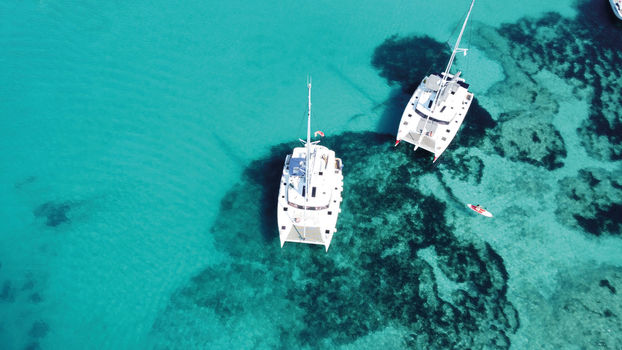
Réglementation et bonnes pratiques de mouillage
Il est essentiel de maitriser son permis bateau pour pouvoir manœuvrer son bateau en toute sécurité, y compris lors du mouillage. En effet, savoir poser l’ancre correctement nécessite une connaissance approfondie des techniques de navigation. Avant de prendre la mer, vérifiez que vous disposez de tout l’équipement indispensable à la navigation et au mouillage de votre bateau. Assurez-vous d’avoir à bord le matériel obligatoire, tel que spécifié dans ce document du Ministère de la Transition écologique et solidaire sur l’équipement de sécurité des navires de plaisance.
Mouiller son bateau implique de respecter les règlementations maritimes spécifiques qui encadrent la pratique du mouillage. Ces règlementations varient d’une région à l’autre, en fonction des lois nationales et des règles locales, et visent à garantir la sécurité maritime, la protection de l’environnement marin et la régulation de l’utilisation des zones de mouillage. Elles peuvent inclure des restrictions sur les emplacements autorisés pour le mouillage, des règles sur les distances entre les bateaux mouillés, des exigences en matière d’équipement de sécurité, ainsi que des mesures visant à prévenir la pollution et à minimiser les dommages aux fonds marins.
Zone de mouillage réglementé
Le mouillage, une alternative intéressante aux places de port sur ponton
Parallèlement aux ports structurants du domaine public maritime, des zones de mouillages et d’équipements légers (ZMEL) ont été développées en dehors des limites des ports de plaisance pour répondre à la demande des plaisanciers sur le littoral.
Les ZMEL sont des zones où des bouées d’amarrage sont installées afin d’accueillir les bateaux dans des conditions respectueuses des impératifs de sécurité ainsi que de protection de l’environnement.
La possession d’une place de port sur ponton peut s’avérer coûteuse pour un voilier, tant sur le plan financier que sur le plan de la disponibilité. Les listes d’attente sont souvent longues et les tarifs élevés, ce qui peut dissuader les propriétaires de petits voiliers. Face à cette réalité, le mouillage apparaît comme une excellente alternative.
En effet, dans un contexte où le marché de la plaisance devient de plus en plus tendu et où de nombreux propriétaires de bateaux sont des retraités, la construction de nouvelles places de port semble peu réaliste. Le mouillage présente alors des avantages indéniables : il est plus durable, moins impactant pour l’environnement et financièrement plus accessible. De plus, les listes d’attente pour obtenir une place au mouillage sont généralement plus courtes, surtout dans des zones moins connues.
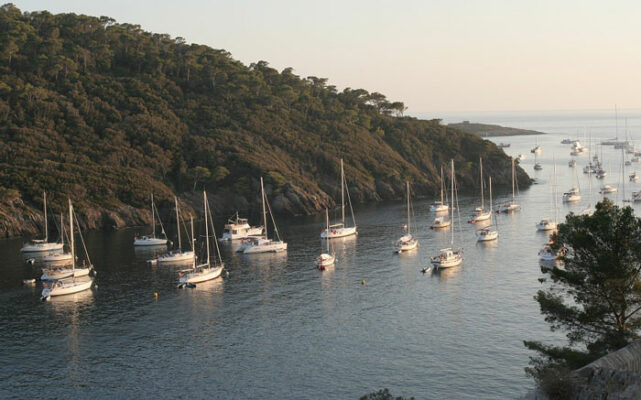
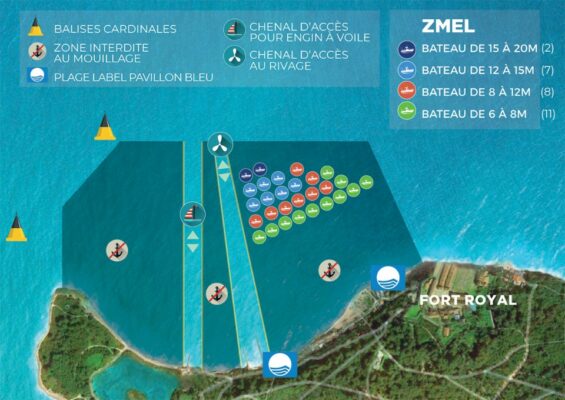
L’utilisation de la zone de mouillage à équipement léger nécessite impérativement la présentation d’une attestation d’assurance valide pour le navire de plaisance, émise par son propriétaire. Un règlement de police précis encadre les règles de navigation, couvrant des aspects tels que le balisage, la sécurité des personnes et des biens, ainsi que la prévention des accidents et de la pollution. La responsabilité de porter ces règles à la connaissance des usagers incombe au gestionnaire, généralement par le biais d’un affichage visible. Le titulaire de l’autorisation peut être tenu responsable de la sécurité et de la salubrité des lieux.
Il convient également de souligner que les règles juridiques visant à protéger l’environnement s’appliquent rigoureusement. Par exemple, certaines zones peuvent être strictement interdites aux bateaux ne disposant pas de systèmes de stockage ou de traitement des eaux usées conformes aux normes. De plus, certaines activités peuvent être proscrites.
Mouillage sauvage
Est il possible de mouiller n'importe ou, même hors zone réglementé ?
Oui et non, en effet le mouillage dit « Sauvage » en dehors des zones organisé comme les ZMEL peut être autorisé sous condition, mais aussi expressément interdit. Le mouillage forain à l’ancre hors zone de mouillage règlementé peut être interdit afin de limiter leurs dégâts sur les milieux marins.
Par exemple L’arrêté n° 123/2019 fixe le cadre général du mouillage et de l’arrêt des navires dans les eaux intérieures et territoriales françaises de Méditerranée. Il précise qu’il est ainsi interdit de mouiller dans une zone correspondant à un habitat d’espèces végétales marines protégées et donc l’herbier de posidonie. Les zones concernées et les seuils des navires (longueur) seront fixés par le Préfet Maritime pour le littoral de chaque département.
Il rappelle qu’un contact par radio (VHF 16) ou, lorsque le navire n’en est pas équipé, par téléphone doit pouvoir être établi en permanence entre le navire et les autorités.
Le mouillage forain est autorisé tant qu’il ne dépasse pas une certaine durée, la notion de mouillage sauvage se réfère à une occupation prolongée et non autorisée d’un emplacement donné sans respecter les règles et les autorisations applicables. Cela peut inclure le dépassement d’une durée spécifique, souvent de quelques jours à quelques semaines, pendant laquelle un bateau peut être autorisé à mouiller dans une zone donnée. Pour mouiller votre bateau, nous vous conseillons donc de demander une autorisation d’occupation temporaire (AOT). Et de vous renseigner sur les zone de mouillage (Natura2000, ZMEL etc…)
